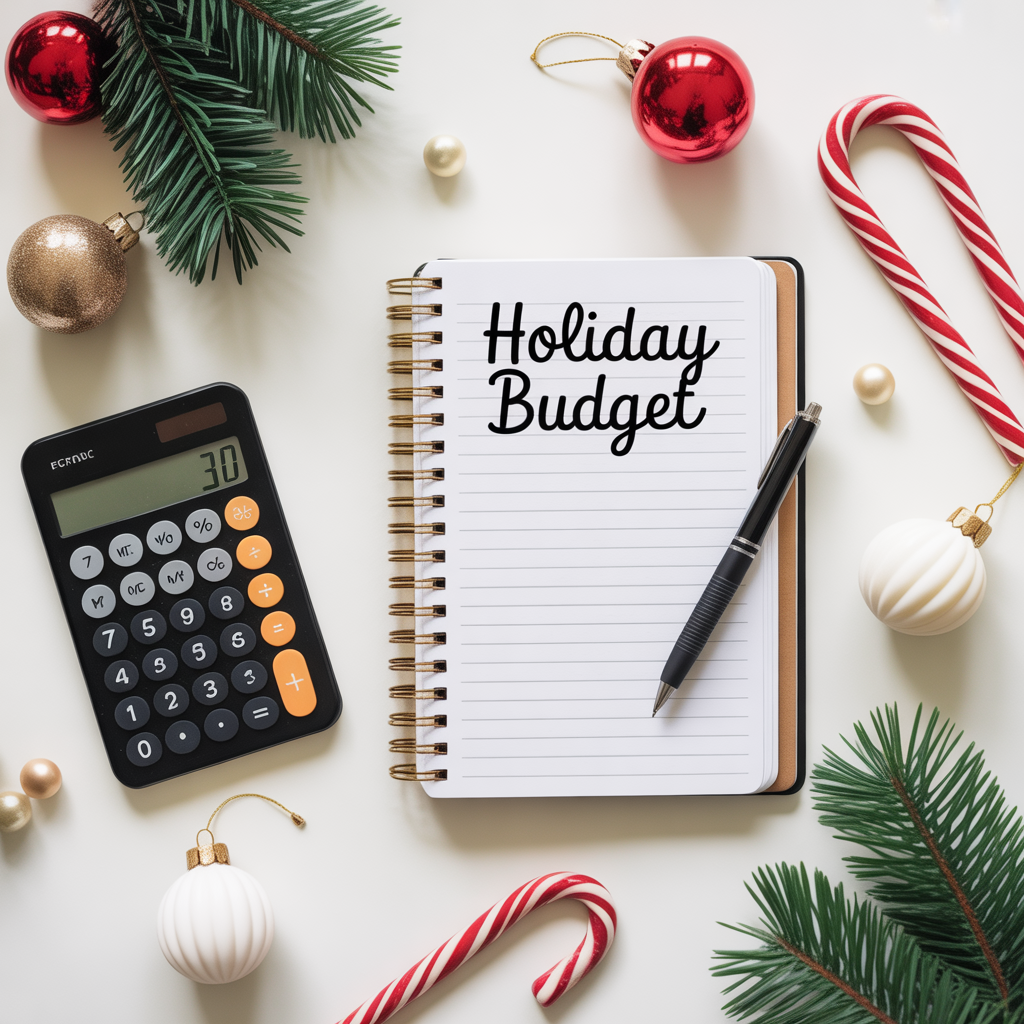7 Holiday Budgeting Tips for Beginners
Holiday cheer doesn’t have to mean holiday debt. With smart budgeting tips, DIY money-saving ideas, and a clear plan, you can enjoy the season without overspending. Start now, build good money habits, and hit January with financial peace instead of regret.

The holidays are creeping up — you can already feel it in the air. Soon it’ll be twinkly lights, family gatherings, and a calendar stuffed with events. Sounds magical, right? Until you look at your bank account in January and realize all that “holiday cheer” came with a massive price tag.
That’s why having a holiday budget in place before the season kicks off is so important. With a few simple strategies, you can enjoy the holidays without piling on debt that lingers into the new year. Think of it as giving yourself the gift of peace of mind.

Here’s the real truth: long-term financial stability doesn’t happen by chance — it starts with financial literacy. Learning how to plan, prioritize, and practice good money habits makes the difference between a holiday that feels joyful and one that feels like financial whiplash.
👉 To help, I created a free guide, 7 Money Rules You Must Learn Before It’s Too Late. It’s the foundation for building healthier financial habits, and yes, it works just as well during holiday chaos as it does the rest of the year.
Ready? Let’s start by looking at why holiday spending gets so out of control.
Why Holiday Spending Spirals Out of Control
Holiday marketing starts early, and it’s designed to make you spend. Before you know it, emotions, FOMO, and “just one more gift” can throw your budget completely off track.
- Emotions hijack math. Love and guilt don’t add up.
- Retail FOMO. “Deals” make us feel like we’re saving by spending.
- No plan. Without clear limits, overspending is almost guaranteed.
The fix? Spot these traps now so you’re not broke (or worse, in debt) come January.
The Psychology Behind Seasonal Overspending
Holiday spending isn’t just about stuff — it’s about feelings. Retailers know this and play on it hard.
- Emotional spending. We want to give joy, avoid guilt, or outdo last year.
- Social pressure. Friends, family, and Instagram make “enough” feel like “too much.”
- Scarcity tricks. “One-day only” deals create panic buying.
When you recognize these triggers, you can pause before swiping your card. That pause? That’s the start of smarter habits that support your bigger financial goals.
How Retailers Trigger Your Spending Impulses
Retailers know how to mess with your brain. Bright red “SALE” tags, countdown clocks, and free shipping thresholds are all designed to make you buy more than you planned. Once you see it as a tactic, it’s easier to walk away.
Holiday Marketing Tactics to Recognize
Watch out for these classics:
- Scarcity: “Only 3 left!”
- Urgency: “Sale ends tonight!”
- Bundling: Buy two, “save” money, but spend more.
Spotting these tricks ahead of time keeps you in control — and helps you stick to your budget instead of theirs.
Creating Your Personalized Holiday Spending Plan
Here’s the truth: if you don’t give your money a job before the holidays, it’ll wander off without asking. A plan keeps you from the “swipe now, cry later” cycle.
- Set a spending limit. Decide how much you can afford before the shopping starts.
- List your priorities. Gifts, travel, food, décor — rank them so you know where to cut if needed.
- Divide and conquer. Break your budget into categories so you know exactly where every dollar is going.
👉 Want a little help? My FREE Financial Planner Bundle (a $47.00 value!) has trackers, planners, and worksheets to map out every dollar — holiday season and beyond.
Tip #1: The 1-2-3 Budget Method by Tiffany Aliche
This beginner-friendly system makes budgeting money way less overwhelming.
- 1: Set aside money for needs.
- 2: Cover your wants.
- 3: Pay off debt + build savings.
Using this during the holidays keeps you focused and stops emotional overspending.
Tip #2: The Holiday-Specific Sinking Fund Strategy
Instead of scrambling in December, start now with a sinking fund. That’s just a fancy way of saying: save a little each week or month toward holiday expenses.
Example: $50 a month = $600 by December. That’s one stress-free holiday. It turns big costs into bite-sized, doable steps.
Tip #3: Setting Up Automatic Transfers to Your Holiday Fund
Make saving easier by setting up automatic transfers to your holiday fund. This way, you save without having to remember.
| Budgeting Method | Description | Benefits |
|---|---|---|
| 1-2-3 Budget Method | Allocate budget into essential expenses, savings, and discretionary spending | Simplifies budgeting, reduces financial stress |
| Holiday-Specific Sinking Fund | Dedicated savings plan for holiday expenses | Ensures funds are available for holiday expenses, reduces debt |

Using these tips, you can have a stress-free holiday season. Begin planning early to get the most out of your holiday budget.
Smart Budgeting Tips for Saving Money During the Festive Season
Holiday joy doesn’t have to mean holiday debt. A few small adjustments can keep things festive and financially sane:
- Use a gift list. Write names + limits before shopping. Stick to it.
- Track in real time. A budgeting app (or plain notebook) keeps you accountable.
- Cap the extras. Décor, food, outfits — set mini-budgets for each.
These little shifts save stress now and help you start the new year on solid ground.
Tip #4: The Cash-Only Christmas Challenge
Want a built-in spending limit? Go cash-only. Withdraw your holiday budget in cash, split it into envelopes for gifts, food, or décor, and once it’s gone — that’s it. No swiping, no overspending.
Meal Planning Around Holiday Leftovers
Meal planning is key to saving money at holidays. By using leftovers in your meals, you cut down on waste and save on food costs.
| Meal Planning Tips | Savings Potencial |
|---|---|
| Plan meals around leftovers | Up to 30% on grocery bills |
| Use a meal planning app | Up to 20% on grocery bills |
| Shop during sales | Up to 40% on grocery bills |

With these tips, you can enjoy the holiday season without spending too much. For more ideas, look into apps that help track leftovers. This can save you money and reduce waste.
Gift-Giving Strategies That Preserve Your Bank Account
Gift-giving shouldn’t wreck your budget. The secret is swapping “spend more” with “spend smarter.” A few budgeting tips:
- Set limits. Decide what you’ll spend per person and don’t budge.
- Focus on meaning. Thoughtful, personal gifts beat pricey ones.
- Try group gifts. One bigger present split among family saves money and stress.

Tip #5: The Four-Gift Rule
This rule keeps gift-giving simple (and affordable). For each person, stick to:
- Something they want
- Something they need
- Something to wear
- Something to read
Tip #6: Experience Gifts That Create Memories Without Clutter
Instead of another sweater that ends up in the closet, give experiences. A cooking class, museum tickets, or even a homemade “coupon” for a coffee date can mean more than pricey stuff.
Tip #7: Creating DIY Experience Vouchers That Wow Recipients
You don’t need a fancy printer to make a gift feel special. Create simple “experience vouchers” — dinner at home, a movie night, a day trip. Handwrite or design them online for free.
Tech-Savvy Holiday Shopping Hacks
Holiday shopping doesn’t have to drain your wallet or your sanity. With the right tech tricks, you can score deals, stay organized, and keep your budget intact.

Price-Tracking Browser Extensions Recommended by Financial Influencers
Why pay full price if you don’t have to? Browser extensions like CamelCamelCamel and Keepa track prices and ping you when they drop.
The Strategic Abandoned Cart Technique for Discount Codes
Here’s a sneaky one: add items to your online cart, then walk away. Many retailers will email you a discount code to reel you back in.
Setting Up Email Filters for Shopping Promotions
Holiday sales = inbox chaos. Create filters so promos land in their own folder. You stay in the loop on discounts without drowning in spam.
Entertaining and Celebrating Without Emptying Your Wallet
You don’t need a five-star budget to host a five-star holiday. With a little creativity, you can throw a celebration that feels festive without sending your bank account into shock.
The "Bring Your Signature Dish" Potluck Revolution
Hosting doesn’t mean footing the entire food bill. A potluck is budget-friendly, fun, and guaranteed to serve up way more variety.
- Coordinate dishes so you don’t end up with seven green bean casseroles.
- Ask everyone to bring their signature holiday dish (bonus: it doubles as a conversation starter).
- Add a theme — like “holiday foods from around the world” — to make it extra fun.
This simple swap saves money, cuts stress, and lets everyone feel part of the celebration.
Upcycled Holiday Decorations That Look Store-Bought
Holiday décor doesn’t have to cost a fortune. Upcycle what you already have — jars, old ornaments, fabric scraps — and you’ll be shocked at how chic it can look.
Nature-Inspired Decor That Costs Nothing
Sometimes the best décor is literally sitting in your yard. Pinecones, branches, and autumn leaves can become centerpieces or mantel accents in minutes. Toss them in a vase, tie them with ribbon, or scatter them across your table for a cozy, festive vibe.

By using these ideas, you can have a great holiday season without spending too much.
Avoiding the January Financial Hangover
The holidays are fun — the credit card bill that follows? Not so much. A little planning now can save you from starting the new year with regret (and a pile of debt).
Ramit Sethi's "Guilt-Free Spending Plan" for Holiday Joy
Ramit’s idea is simple: decide ahead of time how much you’ll spend on holiday fun. When the money’s set aside, you can enjoy every party, cookie, and gift without guilt.
The 48-Hour Rule for Unplanned Holiday Purchases
Impulse buys are the silent budget killer. Use the 48-hour rule: if you see something tempting, wait two days before pulling out the card. Most of the time, you’ll realize it was a want, not a need.
Creating a Post-Holiday Financial Recovery Plan
Even with the best intentions, holiday spending can creep up. In January:
- Review what you spent versus what you earned.
- Cut back on extras for a month or two.
- Focus on paying down holiday debt first, then rebuild savings.
Need a personalized game plan? Book a free Intro Strategy Call with Joy & Jill. We’ll help you map out a realistic recovery plan, set clear financial goals, and build good money habits that last all year.

How to Keep the Holiday Spirit Without the Holiday Debt
The holidays can tempt even the savviest of us to overspend, but with these 7 budgeting tips saving money, you can enjoy the season without maxing out your credit card. It’s not about skipping the joy — it’s about swapping debt-driven stress for real peace of mind.
Simple shifts like creating a spending plan, trying DIY gift ideas, or hosting a potluck keep costs low while the fun stays high. These are the kinds of habits that carry you through January and beyond.
And if you’re ready to take things further, don’t do it alone — book a free Intro Strategy Call with Joy & Jill. Together we’ll map out your financial recovery, set strong financial goals, and build habits that give you stability long after the holiday lights come down.
This season, embrace the true spirit of the holidays: connection, creativity, and celebration — without the debt.
FAQ
What are some effective budgeting tips for saving money during the holidays?
To save money during the holidays, try the 1-2-3 budget method. Also, create a holiday-specific sinking fund. Use cashback apps to earn rewards.
Consider the cash-only Christmas challenge and the "skip-a-week" grocery method. These can help cut down on expenses.
How can I avoid overspending during the holiday season?
To avoid overspending, be smart about retailers' marketing tricks. Use price-tracking browser extensions to stay informed. The 48-hour rule for unplanned purchases can also help. Set up automatic transfers to a holiday fund. This way, you'll stick to your budget.
What are some unique gift-giving ideas that won't break the bank?
Try the four-gift rule for thoughtful presents. It includes something the recipient wants, needs, wears, or reads. Experience gifts, like cooking classes or concert tickets, offer lasting memories without clutter.Create DIY experience vouchers for a personal touch. It makes the gift even more special.
How can I entertain and celebrate the holidays without overspending?
Host a potluck where everyone brings their favorite dish. Get creative with upcycled holiday decorations. Use nature-inspired decor like pinecones, leaves, and branches for a personal touch.
What are some strategies for avoiding post-holiday financial stress?
Use Ramit Sethi's "guilt-free spending plan" to enjoy the holidays without financial worry. The 48-hour rule for unplanned purchases helps too. Create a post-holiday financial recovery plan to pay off debt and rebuild savings.
How can I stick to my financial goals during the holiday season?
Start by setting clear financial goals and making a holiday spending plan. Use budgeting apps and tools to track your expenses. Implement good money habits, like saving a certain amount each month, to stay on track.
What are some DIY money-saving ideas for the holidays?
Try meal planning around holiday leftovers. Use apps to track and organize leftovers and reduce food waste. Create DIY experience vouchers and get creative with upcycled holiday decorations to save money and have fun.
Affiliate Disclaimer
This blog may contain affiliate links, which means I may earn a small commission if you click on a link and make a purchase—at no extra cost to you. As an affiliate, I only recommend products that I personally use, trust, and believe will add value to my readers. Your support helps keep this content free and allows me to continue sharing helpful tips and resources.
I am not a medical professional, and the information provided on this blog is for educational and informational purposes only. Always consult with a qualified healthcare provider before making any changes to your skincare or wellness routine.